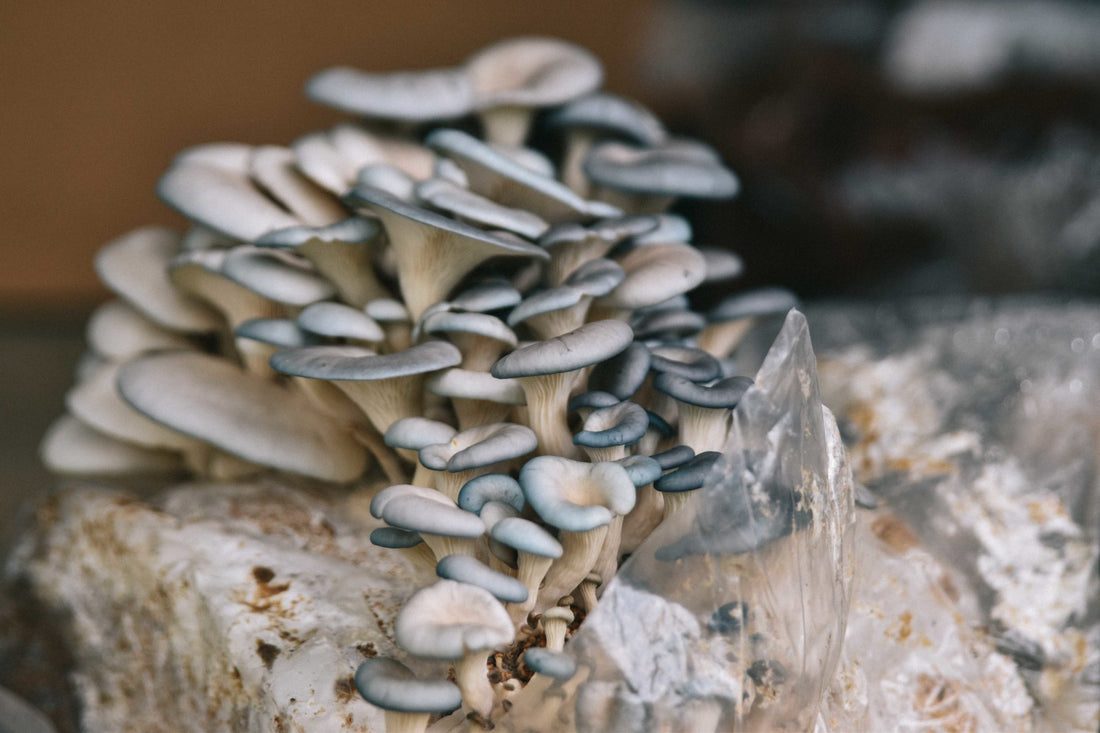Many people are interested in oyster mushroom nutrition information because this easy-to-grow mushroom has gained a lot of popularity over the past few years
Oyster mushroom nutrition is a popular topic because more people are finding this mushroom at farmers’ markets and specialty grocery stores. Furthermore, a greater amount of people are growing oyster mushrooms at home. Many of the oyster species are easier to grow than other mushrooms, so oysters, like the blue oyster in particular, are popping up in more places.
Below we are going over some oyster mushroom nutrition information. If you are interested in growing your own oyster mushrooms at home, we can help! We provide both sawdust and grain spawn for an array of oyster mushrooms so you can grow your own beautiful bouquet at home. We also have oyster mushroom growing kits, which make the process even easier as they can ready to fruit.
Oyster mushroom nutrition to understand
The first study to look at today is entitled ‘Nutritional quality of Oyster Mushroom (Pleurotus Ostreatus) as affected by osmotic pretreatments and drying methods’. I highly recommend reading this study if you cultivate your own oyster mushrooms and dry them.
This
study makes some statements about the healthful constituents in oyster mushrooms that are worth noting. The study states:
“Pleurotus as health promoter and environmental restorer is gaining more importance as compared to other medicinal mushrooms resulting in an upsurge in their research and development activities during the past two decades (Patel, Naraian, & Singh, 2012). The chemical nature of the bioactive compounds present in this mushroom includes: polysaccharides, lipopolysaccharides, proteins, peptides, glycoproteins, nucleosides, triterpenoids, lectins, lipids, and their derivatives.”
This is a good place for us to start looking into the oyster mushroom nutrition facts. Below we get into some specific organ systems and how the oyster mushroom may be helpful there.
Oyster mushroom nutrition includes antioxidants for liver health
A
study entitled ‘Antioxidant activity of the oyster mushroom, Pleurotus ostreatus, on CCl(4)-induced liver injury in rats’ looked at the antioxidant properties of oyster mushrooms and how they impacted rats who were exposed to it.
There were significant increases of serum levels for an array of enzymes, including glutamic oxaloacetic transaminase (SGOT), glutamic pyruvate transaminase (SGPT) and alkaline phosphatase (SALP). These rats were experiencing hepatotoxicity, but when they were treated with extract of P. ostreatus, the serum levels reverted back to the normal levels. According to the results of the study, “Histopathological studies confirmed the hepatoprotective effect conferred by the extract of P. ostreatus. These results suggest that an extract of P. ostreatus is able to significantly alleviate the hepatotoxicity induced by CCl(4) in the rat.”
Oyster mushroom nutrition and heart health
This
next study specifically looked at the pink oyster mushroom (
Pleurotus djamor var. roseus)
. The study I am referring to is entitled ‘Hypolipidemic Effect of Pleurotus djamor var. roseus in Experimentally Induced Hypercholesteromic Rats.’ This study concluded that the pink oyster may be helpful in heart health, although this study was conducted with rats. It would be more helpful to see this type of study conducted with humans as well. Here is the conclusion of the study: “Overall results indicated that P. djamor var. roseus administration reduces the cholesterol levels and have greater significance in prevention of hyperlipidemia or cardiovascular disease.”
Blue oyster mushroom nutrition: Cancer, cholesterol, and
For starters, some studies have shown that oyster mushrooms lower cholesterol in rats significantly and may do the same in humans.
Oyster mushrooms also contain a plethora of valuable constituents, like proteins, amino acids, antioxidants, vitamins and minerals. They are rich in vitamin B and vitamin D. Iron and potassium are also present in these mushrooms.
Blue oyster calories: It is said that a cup (86 g) of sliced blue oyster mushrooms has 37 calories.
Another test-tube study showed that oyster mushrooms helped reduce the secretion of inflammation markers throughout the body. Two additional studies looked at oyster mushrooms and cancer. One study conducted by the Methodist Research Institute’s Cancer Research Lab found oyster mushrooms inhibiting the growth and spreading of breast and colon cancer cells.
A
study entitled ‘Anti-Cancer Effects of Protein Extracts from Calvatia lilacina, Pleurotus ostreatus and Volvariella volvacea’ concluded that blue oysters can “be considered as a source of potential cancer therapeutic agents.”
Growing oyster mushrooms for local sources of nutrition
As mentioned above, you can grow your own oyster mushrooms at home!
Oysters are easier to grow than many mushrooms, they taste great, and they have healthful constituents as you may have discovered above. You can grow oyster mushrooms a few different ways at home. First, you can use
sawdust spawn, which is great for outdoor inoculations involving logs, totems, and woodchips. Second, you could use
grain spawn, which is great for indoor inoculations on straw, coffee grounds, or supplement sawdust. Next, there is
plug spawn, which is used to inoculate logs and totems.
Our final option is the easiest one around. You can grow your own oyster mushrooms at home with one of our mushroom growing kits. Each kit is 10 lbs of colonized substrate, certified organic, and ready to fruit. You should have your first flush of edible mushrooms within two weeks of starting the process, assuming that you keep your kit in desirable conditions. Doing so will help you yield pounds of fresh mushrooms throughout the lifespan of the kit.
We currently have oyster mushroom growing kits of:
- Blue oyster
- Golden oyster
- Pink oyster
- Black oyster
- Phoenix oyster
- King oyster
We have mushroom growing kits of other mushroom species, too.
Check out all of your options here!

